Life & Death in The Sierra Nevadas
“While the pictures of buildings, trains and mountains from these early days are fascinating, what really strikes me are the people. Inching as close as possible to the photographs, I examine the stern and rugged faces, study what they are wearing, how they are standing, who is with whom. There are few smiles, perhaps due to standing so still for the camera, yet no one looks unhappy. My guess is that they are satisfied, proud of what they’ve been working at, their pleasure wrapped up in their accomplishments.”—By Jerry Zimmerman
Squibs & Blurbs
By Jerry Zimmerman
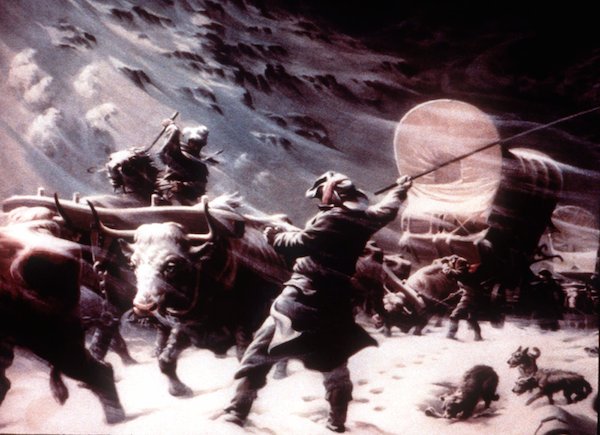
“Thursd. 25th froze hard last night fine & sunshiny to day wind W. Mrs Murphy says the wolves are about to dig up the dead bodies at her shanty, the nights are too cold to watch them, we hear them howl”—From the diary of Patrick Breen of the Donner Party, 1847
TEANECK New Jersey—(Weekly Hubris)—10/20/2014—I am standing in a small museum looking at one of the most beautiful hand-made objects I’ve ever seen.
It is a very large one-man ice saw. The blade is about five feet long, tapered to a blunt point and made of steel. It has surprisingly uniform hand-cut teeth along the working edge. Attached to the wide end is a sensually arched steel bar that ends in wooden handles for a worker’s hands. It takes command of an impressively large space for a hand tool. Made in the late 1800s, not only is it an exquisite object in its own right, it is also an amazing testament to the toolmaker’s creativity and skill, an amalgam of brute force and delicate workmanship.
I am vacationing with my family, and the museum I’m visiting is the Emigrant Trail Museum in Truckee, California, smack in the middle of the Sierra Nevada Mountains.
The museum is dedicated to the history of the town of Truckee and its environs during the second half of the 19th century, the time of the great western migration in America. It is located in the area of the former camp of the Donner Party, the ill-fated emigrant families from Illinois who were stranded here by early blizzards during the winter of 1846, resulting in the deaths of almost half their group of 92 people. During their desperate attempts to stay alive, some members of the party resorted to cannibalism.
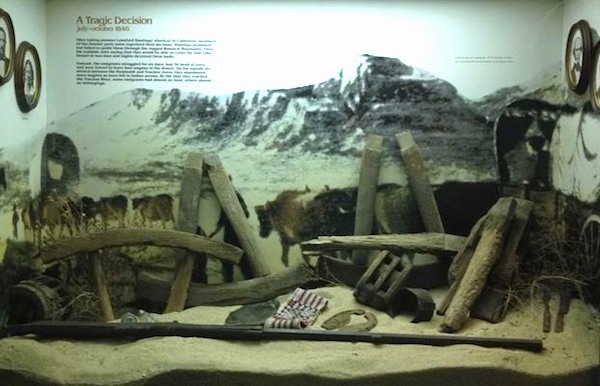
While it is first a memorial for this tragic event, the museum is also packed with artifacts, models, paintings, and photographs documenting the history of the town and the wilderness area around it. The Transcontinental Railroad was built through Truckee in the 1860s and was responsible for its growth from a small settlement into a viable town. The building of the railway through the formidable Sierra Nevada Mountains and the development of a civilized town in the middle of the wilderness are breathtaking examples of pioneer fortitude and ingenuity.
The ice saw is one of those magical objects that seem to transport me back in time and space, dropping me in among those hard, frost-bitten settlers who lived here over 165 years ago. Who was the intrepid craftsman able to hand-cut those saw teeth in such perfect alignment? How was that iron stem forged and bent? How difficult was it, grasping the smoothly worn wood handles, to cut blocks of ice from a frozen lake in the dead of winter?
The settlers are long gone now, there is no one to interview, yet the saw is alive with their presence, more so than any other object on display. It appears to be resting mid-day, soon to be picked up and carted over someone’s shoulder down to the shore for more work.
What kind of people could build such a saw? Who were they?
Amazingly, there are photographs!
I peer intently at the old scenes, searching like a psychic Sherlock Holmes, trying to piece together the feel and the smell and the weight of those days. I am thrilled to “be there” to see those captured Herculean efforts, sprung from the original American Spirit of Can-Do.
Giant trees are felled by men with hand-saws. Long lines of ox teams are hauling impossibly humungous logs on wooden carts. Miles of cavernous wooden snow sheds are built into the sides of steep ravines to shield the workers laying rail tracks. Sawmills and miles-long sluice ways are carved out of virgin forest. Beautifully crafted roundhouses for the first steam locomotives are built. A town is created with covered sidewalks and stores and a railway station. Everywhere are signs of desire, endurance, and hard, hard work.
What a time and a place.
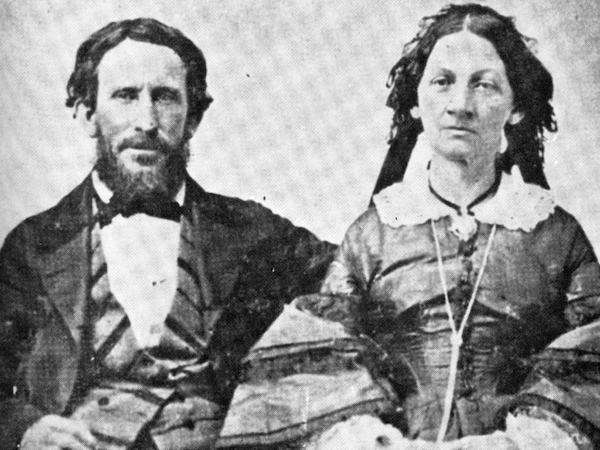
While the pictures of buildings, trains and mountains from these early days are fascinating, what really strikes me are the people. Inching as close as possible to the photographs, I examine the stern and rugged faces, study what they are wearing, how they are standing, who is with whom.
There are few smiles, perhaps due to standing so still for the camera, yet no one looks unhappy. My guess is that they are satisfied, proud of what they’ve been working at, their pleasure wrapped up in their accomplishments.
While gorging myself on these historical wonders, I am summoned by my family to join them outside. There is a small mapped-out hike near the museum, an easy stroll through beautiful and stately pine trees with a small rivulet winding through. On this grey and misty day, the woods are peaceful and bucolic, the air crisp with fresh scents and a surprising whiff of butterscotch from the bark of the Ponderosa Pines.
We come upon a very large boulder sitting right off the path. There is a plaque affixed to it. To my great surprise, it says that this rock was used as part of the cabin that was built by the Breen family of the Donner Party.
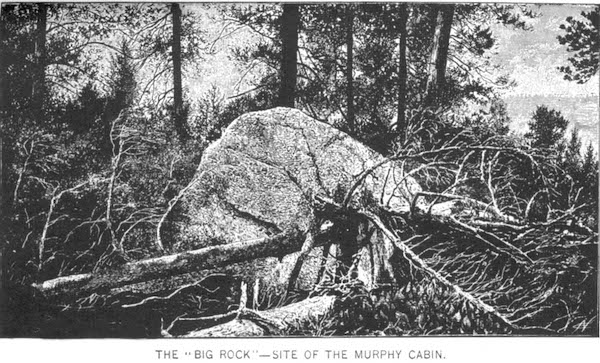
We are standing on the spot that was once their snowbound refuge, the very cabin where they holed up during that treacherous winter of 1846. Being in this area, having just come from the museum, I already feel immersed in their story, but now I have chills; standing, literally, in their footsteps, I feel the years between us melt away.
Later, driving from the museum back to our vacation house, I feel an intense sense of connection to those people living here so long ago. It stays with me even now.
Though Truckee is a modern town with the modern amenities of most American towns, the ever-present Sierra Nevadas and the towering pine forests dominate the landscape, showing the town to be what it clearly is, a small refuge in a big, natural world.
This was the salient fact of life for those settlers—their complete dependence upon and their relationship to the land around them. Quite literally, their very lives depended on an acute consciousness of who they were and where they were.
Back home in suburban New Jersey, the thrill, the beauty, and the real life-and-death power of nature often seem remote and contained. My trip to the wilds of California’s rugged mountains and my hour or two standing in an amazing little museum, immersed in history, remind me of the immense powers of our planet beyond our cozy little towns.
The settlers in the old black-and-white pictures look small and humble against the backdrop of Nature all around them.
We are still those same small people striving to survive in a very big world.
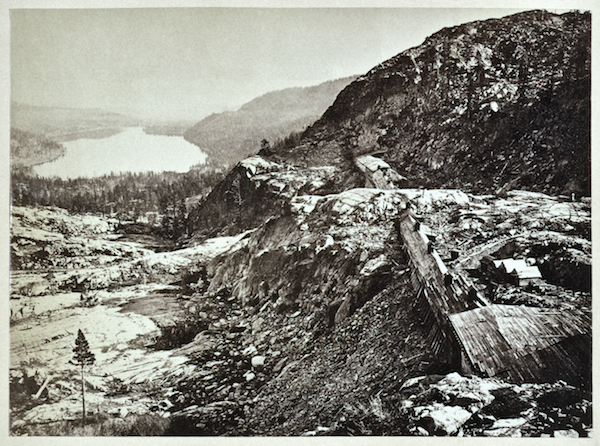
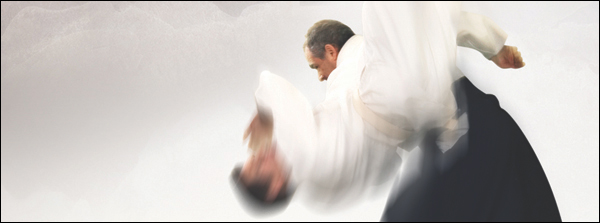

2 Comments
Laura
Well written about a fascinating subject. Love the art :)
jerry
Thanks, Laura, I’m very pleased you liked it! I always knew the Reader’s Digest version of the Donner Party’s expedition, but to accidentally end up standing in their camp was a real jolt – and the museum photographs were particularly mesmerizing. A real time-bending experience.